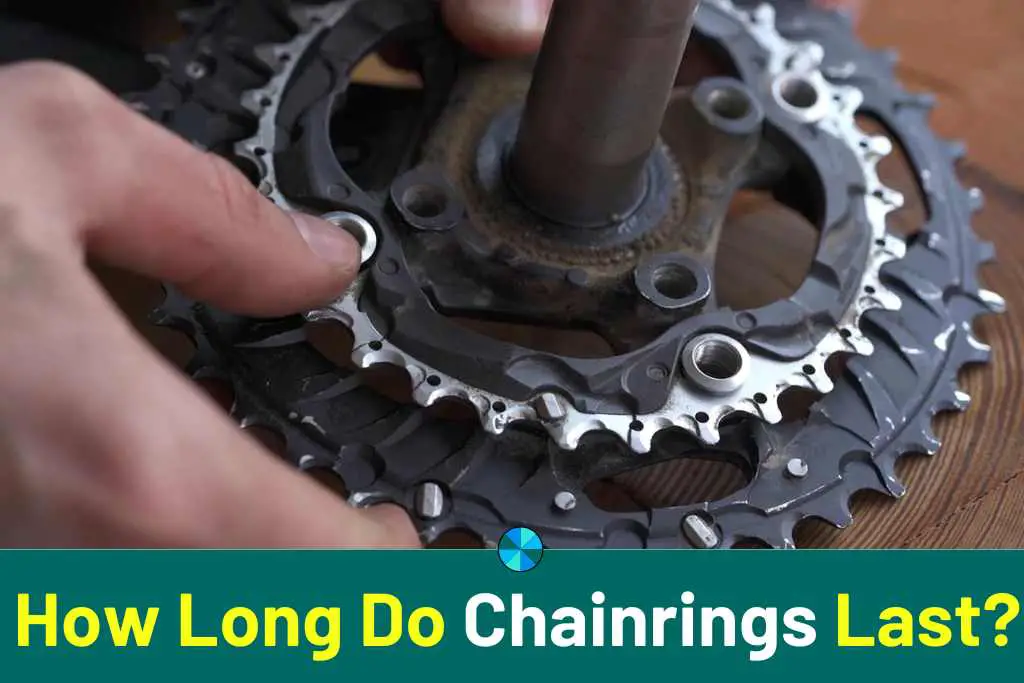Have you ever asked yourself or your friend how long chainrings last? Well, you are at the perfect place to find the answer to such a question.
Looking after your bike is not always a simple task, and you definitely need to keep an eye on all of the moving parts to make sure that everything is as safe and functional as possible. With that in mind, you might be wondering: how long do chainrings last?
The lifespan of a chainring can vary greatly depending on maintenance, general wear, and the material of the ring itself. They can need replacing after just 5,000 – 10,000 miles, but many will last as long as 50,000 miles if properly maintained.
Read ahead to find out more!
What Is A Chainring?
Before we get into the specifics about exactly how long chainrings are built to last and what factors affect this, we should first make sure that we know exactly what it is that we are talking about.
The chainring on a bicycle is the front cog that your chain will be wrapped around. As you rotate the pedal, it forces the chain around and spins the rear wheel. They are attached to the spider of the crankarm on your bike (right between the pedal and the chassis of the bike).
Although this component is commonly referred to as a “chainring” or “chain ring”, they actually go by a number of different names. Chainrings are also sometimes called:
- Sprockets
- Chainwheels
- Crankset
- Chainset
Technically, each one of the individual chainrings is part of the overall “crankset” or “chainset”. They have teeth around the outside which engage with each link of the chain as it passes over.
The chain then wraps around the cassette which is usually attached to the rear wheel.
Most bikes will have two or three chainrings of different sizes, although some do have just one.
How Long Do Chainrings Last?
It’s hard to say exactly how long a chainring is going to live, as it can vary greatly. They are essentially designed to last for as long as the bike is, but they can wear down quite significantly if they are not properly maintained or if they are battered through intensive use.
Most chainrings can survive for 50,000 miles or more without being replaced, but some cheaper rings can become worn down after just 5,000 – 10,000 miles if they are not properly cared for.
There is a general rule that you can follow to help you determine when it might be time to think about getting a new chainring.
- You should replace your chain about every 1,000 – 3,000, depending on how hard the bike has been ridden.
- Once you have replaced your chain 3 or 4 times, you should replace your cassette.
- Once you have replaced your cassette twice, you should replace your chainring.
Read also >> How Often Should I Clean My Bike Chain? (Here Is Why…)
Read also >> Bike Chain Noise in High Gear (4 Reasons Why)
Do More Expensive Chainrings Last Longer?
The material that is used to construct your chainrings will affect how much it will wear down over time, but the quality of its manufacturing does influence things significantly as well.
Cheaper cranksets might have the chainrings directly welded or riveted onto the crank arm, which is likely to increase natural wearing.
With this kind of chainring, you will generally need to replace the entire crankset when something does become damaged.
More expensive cranksets, however, will have the chainrings bolted into place. This means that they can be individually replaced.
When it comes to the materials, most chainrings will be made from an aluminum alloy, because it is strong but lightweight.
Steel is another popular option, but you can also find some chainrings that are constructed using titanium or carbon fiber.
Aluminum chainrings are slightly lighter than steel options, although steel is a little bit stronger and is likely to last longer. Both titanium and carbon fiber are generally much less common and more expensive. Titanium is more durable, whereas carbon fiber is lighter and stiffer, but more brittle.
What Affects How Long Chainrings Last?
Besides the construction and materials involved, there are a number of other factors which will affect how long your chainrings are actually going to last.
The most important of these is the wear that the chain itself is putting onto your chainring.
A worn-down or improperly oiled chain will start to damage the teeth of your chainring, so chain maintenance is key. Usually, your chainring will be the last thing to become worn out of all the drive components.
Additionally, the amount of mud, dirt, and grime that gets into your chain will increase how much it wears down the teeth of your chainring, and more intense and high-speed cycling will usually wear a chain down faster.
To Make Your Chainring Last
If you don’t want to end up replacing your chainring too often (if at all), then there are a few ways to make it last as long as possible.
- Maintenance. Make sure to oil and replace your chains as often as they need.
- Care. Try not to cause any damage to the chainring and prevent it from taking significant hits.
- Cleanliness. Removing gravel, mud, dirt, and any other debris will reduce the amount of wear on your chain and chainrings.
- Smooth Gear Changes. The smoother your gear changes are the less strain you will be putting on your drivetrain overall.
How Can You Tell That Your Chainrings Need Replacing?
Obviously, understanding when to replace your chainrings is not a predictable science. You can’t tell exactly how much they are going to wear down over time, or when they will receive any significant damage.
Instead, you should make sure to keep an eye on the condition of your chainrings so that you can tell when you might need to get new ones put in.
Look at the teeth on your chainring for any nicks or smoothing that indicates it has become worn down. If your chainring has been struck while you are out and about, you should make sure to check for any cracks or marks.
What Type Of Chainrings Do I Need?
There are different sizes of chainrings that you can use, and the options can be quite confusing to understand. They can be as small as having just 20 teeth, or large enough to have 60 teeth or more.
The number of teeth on your chainring will affect how your bike feels to ride. Some of the most popular options include:
- 50-Tooth Chainring: Endurance bikes and cheaper bikes often have compact 50-tooth chainrings. They allow you to pedal comfortably even in higher gears, which makes them good for most terrain types. The top speed is slightly lower, however.
- 52-Tooth Chainring: The next step up is a semi-compact 52-tooth chainring. This allows you to move more quickly at high gears, although it does require slightly more effort to drive the wheel.
- 53-Tooth Chainring: One of the most standard options that racing bikes use is a 53-tooth chainring. It is easier to keep up with the rotation of a slightly larger gear like this, and you will move faster at top speeds.
Generally, it’s better to opt for a bigger gear if you want to move more quickly on flatter terrain, whereas a smaller gear is better for hills.
The size and number of teeth of your chainring won’t usually affect how long they will last.
You can also choose between an oval or a round chainring, with the oval option being slightly more efficient and putting less stress on your knees.
Summary
So, how long do chainrings last? It is very hard to tell and depends on a number of factors. The materials and construction of your chainrings will affect how long they will last, as will the way that you look after them.
Some chainrings can last for more than 50,000 miles – pretty much as long as the lifespan of the bike itself.
With that being said, they can become worn down after just 5,000 miles or so if they are poorly constructed and improperly maintained.

